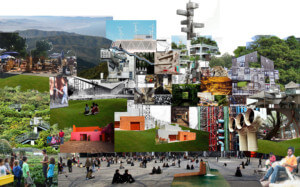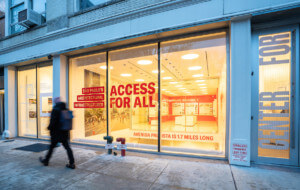| Brought to you with support from: | |
|
|
|
Students use parametric design to fashion a porous architectural screen that draws from contemporary marble sculpture.
In the third edition of Mark Foster Gage’s Disheveled Geometries seminar at the Yale School of Architecture, students Mary Burr and Katie Stranix began their exploration of extreme surface textures with marble. Inspired by the sculptural work of Tara Donovan and Elizabeth Turk, the student duo set out to design a delicate yet porous screen that transformed a two dimensional panel into a rhythmic and dynamic 3D structure.
According to Stranix, the first design emerged as an aggregation of several different parts and wasn’t intended for parametric processes. “We wanted to maintain delicacy in our design but add porosity,” she told AN, referencing Herzog & de Meuron’s ground level screen at 40 Bond Street in Manhattan. Working in Maya, the students added elliptical apertures in varying diameters to transform the two-dimensional form in a wavy, 3D screen that departed significantly from a standard panel format.
- Fabricators Mary Burr, Katie Stranix
- Designers Mary Burr, Katie Stranix
- Location New Haven, Connecticut
- Date of Completion May 2013
- Material Obomodulan high density foam, automotive primer and paint
- Process Maya, Mudbox, Zbrush, Powermill, KUKA robot, drilling, hand sanding
To add texture to the screen, Stranix and Burr imported their work to Mudbox, but found the renderings ineffective. Though the mockups weren’t to scale, extrapolations of the desired micro-texture resulted in a polygon count “somewhere in the millions,” Stranix said. “If we were going to get it fabricated on the real material, the count would have to be under 12,000.” The same micro-texturing attempts were made in Zbrush—the program that rendered the wrinkles on King Kong’s face in Peter Jackson’s 2005 remake—but that also produced the same dissatisfactory outcome due to their lack of access to a very small mill.
Going back to the drawing board, Burr and Stranix decided to try using a KUKA robot CNC router to apply the desired texture that would appear naturally from veining in marble. “Marble was so prevalent for so many years, and now it’s nearly obsolete,” Burr said. “Architectural materials are desired for their smoothness, so building up that curvature was a rethinking of that.”
Taking advantage of the KUKA’s ability to execute undercuts, texture was added with a broader jump of the drill bit across a 20-inch-by-40-inch panel of Obomodulan, a high-density foam. Working in Powermill, the students designed a path to carve the elliptical grooves but also tolerated machine-induced variations. With this method, the process generated deep variations in texture. The highest point measured about 6 inches, whereas the lowest point was only 2 inches.
The final finishing was achieved by approximately 14 hours of hand sanding. In addition, any crevices the robot couldn’t reach were drilled out by Burr and Stranix. “Technically, it all could have been done robotically, but we didn’t have an end mill that small in diameter,” Stranix said. A smooth seal was applied with automotive primer and paint.










